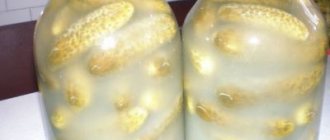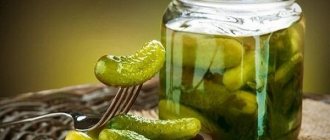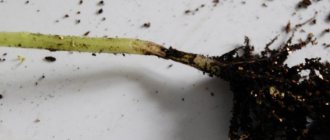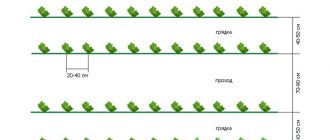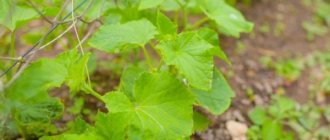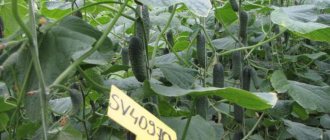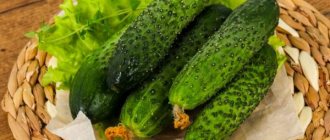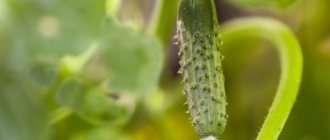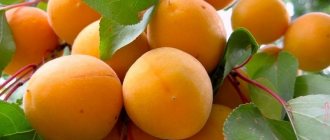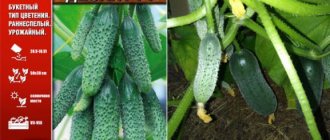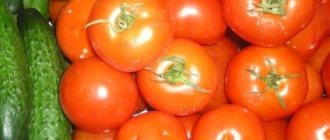Characteristics and description of the variety
growing the cucumber variety Masha F1 in a greenhouse; open ground can only be used in the southern regions of the Russian Federation.
Cucumbers Masha F1:
- Characterized by high productivity;
- They are distinguished by their early ripening; with proper care, fruiting begins 36 days after the shoots appear;
- They are classified as parthenocarpic, i.e. pollination by insects is not required for fruit formation;
- They have green or dark green, medium-wrinkled, medium-sized leaves;
- They have a female type of flowering and a determinant type of growth, in which the main stem is limited in development when a flower cluster appears on it; many shoots are not formed on the bush, which means there is no need for labor-intensive formation of the plant;
- They are distinguished by abundant fruiting, due to the fact that the ovaries are characterized by a bouquet formation (nodes can include about 7 fruits);
- When grown in a greenhouse, they have an average yield of 10 to 11 kg/m. sq. and a commercial product yield of 95%.
Fruit characteristics
- The fruits are cylindrical in shape and dark green in color, including light stripes, the spotting is weakly expressed;
- They are distinguished by thick skin with white pubescence and large tubercles, as well as pulp, which lacks bitterness;
- The average diameter of the fruit is from 3 to 3.5 cm,
- Average weight from 90 to 100 g;
- The length of the fruits can be up to 11 cm, but if you pick cucumbers measuring from 8 to 9 cm, then a larger number of ovaries will subsequently form and the overall productivity of the plant will increase;
- Untimely harvested, overgrown cucumbers deteriorate in taste, and in addition, they reduce the amount of nutrients supplied to the rest of the fruits.
Description of the hybrid
The cucumber hybrid Masha was bred by a group of Dutch breeders from the Seminis company and registered in the State Register of Russia in 2000. The hybrid is recommended for cultivation both in open ground and in greenhouses in all regions of Russia in gardening partnerships and homestead and small farms.
Zelentsy hybrid Masha
Masha cucumber bushes are medium-sized and determinate. The latter means limited formation and growth of shoots, and this greatly facilitates the formation of cucumber bushes.
Masha cucumbers are parthenocarpic, that is, they set fruit without the participation of bees, which allows them to be safely grown in greenhouses at the earliest possible time, when there are not yet enough insects for pollination.
The leaves of cucumbers are small, dark green, and averagely wrinkled. This hybrid produces only female flowers.
Photo
The photos below show the cucumber variety Masha F1 :
Soil requirements for planting
You need to start preparing the soil in advance, preferably in the fall. Manure, wood ash and nitrophoska (3 buckets/3 cups/100 grams per square meter) to the area of the planned cucumber beds
The soil must be dug up with fertilizer and the surface thoroughly loosened to prevent the formation of rocks. In spring, the soil is dug up again and beds are formed.
If autumn work to enrich the soil with nutrients has not been completed, in early spring, spread manure in a thin layer on the site of future plantings and cover it with fertile soil (a cushion of at least 20 cm).
An alternative is to introduce a mixture of ash and superphosphate (1 cup/2 tablespoons per 1 m2) onto the area.
If there is humus , you can add it in the amount of 1 bucket per 1 m2. The procedure will be completed by watering the future beds with a solution of sodium humate (1 tablespoon per 10 liters of water).
The soil must be dug up with fertilizer and the surface thoroughly loosened to prevent the formation of lumps
When growing seedlings, a substrate is used, including: peat, sand, humus, leaf soil (all components are taken in equal parts). It is advisable to pour boiling water over the resulting mixture and leave for 5 minutes in an oven preheated to 200-250°.
This treatment ensures the destruction of pathogenic bacteria and pest larvae that pose a danger to the new crop.
When choosing a place to plant cucumbers, preference should be given to areas where legumes, cabbage, and onions (for turnips) were grown. The worst predecessors are: pumpkin, zucchini, squash, melon.
The soil for cucumbers should be light and non-acidic. An area with high groundwater levels is not suitable.
Advantages and disadvantages
Like any variety, Masha F1 cucumbers have their own advantages and disadvantages. The hybrid has the following advantages:
- It is especially early ripening, even among early varieties.
- It has a high marketable fruit yield (from 95%).
- The female type of flowering ensures high yields, over 10 kg/m. sq.
- One node can include about 7 ovaries, due to which the variety has friendly fruiting.
- The fruits can be harvested in the size of gherkins.
- Cucumbers have an excellent taste when used fresh or when canned.
- The hybrid is resistant to diseases, which allows you to achieve a good harvest.
- The fruits retain their properties during transportation.
Among the few disadvantages, it should be noted:
- thick skin, which some may not like;
- lack of a rich, pronounced aroma;
- the tendency of fruits to outgrow, which necessitates daily harvesting;
- Overgrown cucumbers experience a deterioration in taste.
Reference! It must be taken into account that it makes no sense to collect hybrid seeds, since their qualities are not passed on to subsequent generations.
Watch the video! Cucumber Masha
Reviews
Both German F1 and Masha F1 are excellent hybrids, they are similar in many ways, but the first is still for glass greenhouses, the second is for film ground greenhouses. The hybrids themselves are good, but the quality of seed production is not very good. I have the opportunity to sort through their seeds every day and I will say that there are a lot of puny ones (by our standards), the seeds are poorly made, and the inlay is falling off.
Askar
https://greentalk.ru/topic/1511/
I also plant early seedlings in the garden: Masha, Mila, Bouquet (hybrids) - Dutch. So they bear fruit to the last, universal. 5+.
o-la-la
https://www.tomat-pomidor.com/newforum/index.php?topic=1724.0
Cucumber Masha F1 is really popular not only among summer residents, but also in industrial production. This variety can be grown in open and closed ground. The undoubted positive qualities of the variety are its ability to self-pollinate and good transportability, for which it is valued by agricultural producers.
bmwm3000
https://www.agroxxi.ru/forum/topic/6244-correct-choice-of-cucumber-seeds-forum-recommendation/
I know people who raise Masha and Miranda. These cucumbers can be kept for 5-6 days without losing their presentation, due to the fact that their skin is thicker.
moldigal
https://fermer.ru/forum/zashchishchennyi-grunt-i-gidroponika/3709
Masha F1 is suitable for growing on an industrial scale. The variety is productive, universally used, cucumbers are stored fresh for a long time, do not deteriorate during transportation, and are resistant to mechanical damage. But the variety will reveal its full potential only in greenhouses.
- Author: Marina Volkova
My hobbies: plant growing, healthy lifestyle, Tibetan medicine, home winemaking. A merchandising specialist by training. Rate this article:
- 5
- 4
- 3
- 2
- 1
(1 vote, average: 5 out of 5)
Share with your friends!
Features of cultivation
When growing the cucumber hybrid Masha F1, there are no special agricultural techniques that differ significantly from those generally accepted for other varieties.
Methods for growing Masha F1 cucumbers can be divided into:
- Rassadny. Seeds are planted for seedlings in April. Plants are planted in a permanent place in May, when they have 3-4 full-fledged leaves.
- Seedless. Seeds are sown in the ground at the end of spring to a depth of no more than 3 cm and covered with film.
For planting both seeds and seedlings, a 30*50cm pattern is used, the maximum density is 4 plants per 1 square meter. m.
When replanting seedlings, it is important to know that buried plants will not begin to grow until additional roots have formed on the sections of the stems located in the soil. This occurs within a period of 7 to 30 days.
Masha F1 cucumbers should not be planted in a place where pumpkin cucumbers previously grew, as this leads to a decrease in yield.
Further agricultural technology for the Masha F1 cucumber variety is as follows:
- Watering. It must be regular, as this has a direct impact on productivity. As a rule, plants are watered up to 2 times during the week, daily in dry weather;
- Weeding. Taking into account that the root system of Masha F1 cucumbers is superficial, weeding should be carried out with special care;
- Hilling up. Up to 2 times during the entire growing period;
- Fertilizer. On the eve of the start of mass flowering, at the moment the first flowers appear, it is necessary to feed the cucumbers with organic fertilizers. They have a positive effect on the growth, development of greenery and high yield of the Masha F1 variety. For this, it is good to use manure dissolved in water in a ratio of 1:10. Ash added to the mixture promotes the active growth of cucumbers. The use of phosphorus mineral fertilizers, which are involved in the proper formation of plant roots, is also justified. But potassium fertilizers should not be used, since cucumbers do not need them for fruiting, like tomatoes, for example.
- You can use a trellis as a support for bushes. The experience of gardeners suggests that this prevents damage and rotting of cucumbers, infection with fungal diseases, protects plants from weeds, and promotes good access to air and light.
- For growing cucumbers, it is important to choose sufficiently illuminated areas, with the exception of arid and southern regions, where planting is recommended in shaded areas, which helps prevent sunburn.
- The cucumber variety Masha F1 is rarely affected by cladosporiosis (olive spot), cucumber mosaic, and powdery mildew. If the first signs of other diseases appear, plants should be sprayed with special products, which helps prevent their death.
Diseases and pests
Although the variety is resistant to many typical cucumber diseases, under unfavorable conditions the plant can be affected by anthracnose, white rot and other ailments.
Table: diseases of the hybrid Masha F1
| Diseases | Signs of manifestation | Prevention | Control measures |
| Cucumber mosaic | leaves and fruits become mottled and deformed |
| Treatment with Fundazol no later than 10 days before the start of cucumber harvesting according to the instructions for the drug. |
| Anthracnose | White or light yellow spots appear on the leaves |
| Treatment with Hom or Ridomil-Gold according to the instructions for them. |
| Downy mildew | brown spots appear on the leaves, which later turn into a fluffy coating | sprinkling leaves with crushed wood ash | Treatment with Fundazol (according to instructions). |
| White rot | a white fluffy coating forms on the affected parts of the plant, including fruits | sheltering bushes when cold weather sets in in summer |
|
Diseases of the hybrid Masha F1 (photo gallery)
When a cucumber is affected by mosaic, the leaves become speckled.
With anthracnose, characteristic spots appear on the leaves.
A fluffy coating is a characteristic sign of powdery mildew infection.
White rot leads to crop loss
Table: pests of hybrid Masha F1
| Pests | Signs of manifestation | Prevention and control measures |
| Aphid |
| Spraying with infusion of tobacco dust, wood ash, soapy water, Fitoverm (according to instructions). |
| Trips |
|
|
| Spider mite |
|
|
| Slug |
|
|
Photo gallery: pests of hybrid Masha F1
Aphids like to be located on the inside of the leaf
When affected by thrips, cucumber leaves curl
A sign of a spider mite is a thin web on the back of a leaf. These “beauties” can be found in warm and humid conditions
Care
In general, the agricultural technology of the Masha variety is simple, there is no need for special treatments. Care involves standard procedures for fertilizing, irrigation, weeding and loosening.
Irrigation
The plant should be watered every 1-2 days , depending on the intensity of drying of the soil.
It is ideal to use sprinkling ; high pressure can expose the root part, which will provoke rotting of the crop. Irrigation in furrows and a drip system are also suitable.
When growing horizontally, it is recommended to water the entire area where the vines are located. The liquid rate before the flowering period is 1 liter per bush, after the flowers appear - 2-2.5 liters per plant.
After irrigation, the soil needs to be mulched to prevent rotting of ripening fruits.
Water every 1-2 days by sprinkling or drip method
When and what to feed
If the soil has been properly prepared, then you need to feed the crop at the beginning of flowering and every 10 days after .
For these purposes, organic and ready-made complex fertilizers are used, which can be alternated.
From organic matter, infusions of mullein (1:10), bird droppings (1:25) or nettle (1:5) are most often used. Add wood ash (1-2 cups) to the prepared solution. The rate of application of nutrients is 500 ml per bush.
Ready-made fertilizers are suitable : Agricola for cucumbers (25 g per 10 l of water), Fertika Lux (20 g per 10 l of water), BioMaster for cucumbers (25 g per 10 l of water), etc.
Whatever baits are used, they should be introduced in liquid form after watering .
You need to feed at the beginning of flowering and after it every 10 days, alternating organic and ready-made complex fertilizers
Weeding and loosening
In order for the soil to remain light and oxygen to freely penetrate into its structure, it is necessary to periodically carry out aeration .
This process is combined with the removal of weeds, which provoke rotting of cucumber vines and fruits. The frequency of treatments is once every 1-2 weeks.
You should not bury the tool deeply into the ground, so as not to damage the root system.
It is also useful to carry out hilling of bushes . To form a bush by increasing the number of lashes, it is recommended to pinch off the top above the fifth leaf.
How to shape cucumbers correctly:
Seedling method of growing cucumbers Masha F1
The seedling method of cultivating crops makes it possible to harvest the crop as early as possible. In addition, it is possible to control conditions - temperature, level of illumination and humidity. In this case, you need to adhere to the following rules: When the seeds are planted, the temperature should not exceed 28 degrees. How to plant cucumber seedlings - read here. When the first shoots appear, the temperature decreases (maximum +18). 7-10 days before picking to a permanent place, the seedlings are hardened. To do this, the culture is taken to a cool place (first for an hour, then the time gradually increases).
Useful articles for gardeners and gardeners
Tilling the land before planting
How to water strawberries for a high yield
Picking tomatoes in April 2021 according to the lunar calendar
Planting pepper seedlings in 2021 according to the lunar calendar
For successful survival of seedlings at the place of growth, a soil temperature of at least 10 degrees is required.
If at the time of planting the seedlings it is still cold, then we make a simple shelter from film or plastic water bottles.
https://youtu.be/7ObL94olS7o

